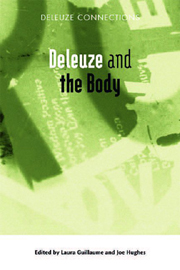Book contents
- Frontmatter
- Contents
- Introduction: Pity the Meat?: Deleuze and the Body
- DELEUZISM
- 1 Time and Autopoiesis: The Organism Has No Future
- 2 Larval Subjects, Autonomous Systems and E. Coli Chemotaxis
- 3 Bodies of Learning
- 4 Believing in the World: Toward an Ethics of Form
- 5 Matter as Simulacrum; Thought as Phantasm; Body as Event
- PRACTICAL DELEUZISM
- Notes on Contributors
- Index
4 - Believing in the World: Toward an Ethics of Form
from DELEUZISM
Published online by Cambridge University Press: 12 September 2012
- Frontmatter
- Contents
- Introduction: Pity the Meat?: Deleuze and the Body
- DELEUZISM
- 1 Time and Autopoiesis: The Organism Has No Future
- 2 Larval Subjects, Autonomous Systems and E. Coli Chemotaxis
- 3 Bodies of Learning
- 4 Believing in the World: Toward an Ethics of Form
- 5 Matter as Simulacrum; Thought as Phantasm; Body as Event
- PRACTICAL DELEUZISM
- Notes on Contributors
- Index
Summary
We need an ethics or a faith.
(Deleuze 1989: 173)Cinema 1 could, without too much distortion, be read as an extended theory of the body. Adapting some of Bergson's theses from Matter and Memory to his own ends, Deleuze outlines the body's immersion in matter; he describes the ways in which it subtracts itself from this matter by selecting, reorganizing, and reacting to it; and, through the theory of the cliché, he begins to account for the ways in which the body can be co-opted and covered over by codes, concepts, institutions, and rituals. Ultimately it is the body that ‘explains’ cinema. Cinema's images ‘express’ perception, affection, and action, and its narrative would be unrecognizable were it not for the natural causality of the action-image.
Cinema 2, however, begins with the crisis of action. Characters no longer know how to respond to situations, and, like Karin on the side of Stromboli's volcano, they freeze in moments of helplessness. In this crisis of action, the body vanishes from the horizon of Deleuze's inquiry. Cinema becomes defined as thought and thought becomes defined as a set of alogical connections and irrational cuts aligned along an infinite series of anamorphoses. What is more, this state of non-action, in which cinema comes into contact not with perception, feeling, or action, but with a disembodied, ‘immaterial’ thought, does not simply represent the inactivity of cinema; it represents cinema's essence.
- Type
- Chapter
- Information
- Deleuze and the Body , pp. 73 - 95Publisher: Edinburgh University PressPrint publication year: 2011



